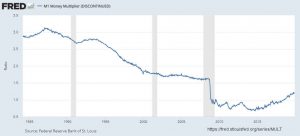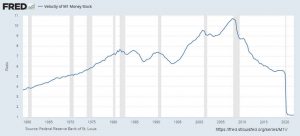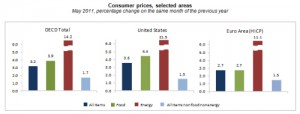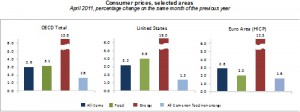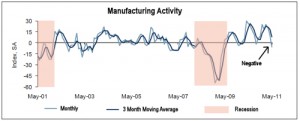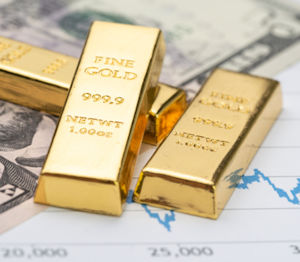What is the Money Multiplier? In a fractional reserve system like we have here in the United States, money is loaned out by banks and by law they are only required to have a fraction of the amount they loan out. For example, they might be required to keep 10% in reserves. In other words, they may have $10 million dollars in deposits but because not everyone will come in to claim their dollars at once the bank may loan out $9 million dollars. But the multiplication doesn't end there. The $9 million will be deposited at another bank and that bank can loan out 90% of that or $8.1 million. And that will be deposited in another bank, who can loan out another 90% and so on. In our article, How … [Read more...]
Velocity of Money
What is the velocity of money? Simply defined, the velocity of money is the turnover in the money supply. A shop owner can measure how fast his inventory is selling by calculating "inventory turnover." To do that, he simply calculates Total Sales ÷ Average Inventory for the period in question. See: Inventory TurnOver for more information. But if you expand the idea of turnover to the entire country, you get the "Velocity of Money". Strictly speaking all the velocity of money tells us is how long people hold onto their money. But from that we can infer their motives and perceptions of the economy in general... The Velocity of Money Calculation To Calculate the Velocity of Money, you … [Read more...]
Market Turbulence
Alan Greenspan was appointed Fed chairman by Ronald Reagan in August 1987, he was reappointed by Bush and Clinton, at successive four-year intervals until retiring after a record-setting tenure on January 31, 2006. During that time period he was one of the most powerful men in the world. The stock markets literally hung on his every word. People made it their full time job to try and decipher what cryptic meaning might be obtained from his press releases. At times his words boosted the market as he dealt with issues like the Black Monday stock market crash that occurred shortly after he first became chairman. At other times he tried to talk the market down and he referred to the … [Read more...]
Can You Really Get a Free Credit Report?
Anyone who has surfed the web long enough has probably seen offers for "Free Credit Reports" but when you go there you usually find that it is just a scam that requires you to register or buy something first. Well, I recently found the one true source of free credit reports and actually was able to verify it with the Federal Trade Commission! I strongly recommend that before you sign up for any free credit report that you check it with the FTC. (See the end of this article for a link to the FTC). -- editorIn the United States, there are three main credit reporting companies they are Equifax, Experian, and Trans Union. They are strictly monitored by the Federal Government and are required … [Read more...]
Free Resources
Free Resources for Investors. (Limit 1 Per Person) Learn to think for yourself Make your own decisions and be your own person. Change the way you invest forever. Download the information the FED doesn't want you to read. Discover the trade set-ups of a lifetime just waiting for you to snag them. Check it out … [Read more...]
May Inflation Surges to 3.2% in OECD Countries
The Organization for Economic Co-operation and Development (OECD) has finished aggregating the May inflation data provided by its member countries and has released the results. Energy prices were up a whopping 14.2% for the 12 months ending in May while food prices were up by 3.9%. The overall average for all products in all the OECD countries was 3.2% in May. This was up from the 2.9% reported in April. The major components of this increase were mainly a sharp acceleration of inflation in Canada (to 3.7% in May, up from 3.3% in April) and the United States (to 3.6%, up from 3.2%) with high food and energy prices being the main drivers. The following chart breaks the components down by … [Read more...]
April Inflation Up in OECD Countries
OECD annual inflation continues rising to 2.9% in April 2011 The Organisation for Economic Co-operation and Development (OECD) released the April inflation numbers for its member countries today. Although we have known the U.S. inflation numbers for a couple of weeks now it is interesting to see how they compare to other developed countries around the world. Some of the biggest gainers were the United Kingdom (to 4.5% in April, up from 4.0% in March) and the United States (to 3.2%, up from 2.7%). Inflation also accelerated in Germany (to 2.4% up from 2.1%), Italy (to 2.6%, up from 2.5%), France (to 2.1%, up from 2.0%) and Japan (to 0.3%, after four consecutive months at 0.0%). Average … [Read more...]
Raw Materials Price Inflation Skyrockets– Manufacturing Collapses
According to the May report of the Richmond FED-- the index of manufacturing activity fell 16 points from a positive level of 10 in April to a declining (negative level) of -6 in May thus indicating that manufacturing actually contracted during the time period. During this same time the cost of raw goods required to manufacture goods increased dramatically. Inflation was the monthly equivalent of an average annual rate of 6.12% in May the highest monthly reading since December 1993 up 27% from April's equivalent of 4.81%. As I've said many times 5% annual inflation will stifle the economy 6% is pretty devastating. Manufacturing activity in negative territory is a sign of a recession … [Read more...]
Soros Sells Gold- No Longer Fears Deflation???
When I think of using gold for asset protection I think of it for protection against inflation. But obviously, according to the WSJ, I am all wrong (or maybe not). According to a Wall Street Journal article, billionaire George Soros sold his $800 million stake in precious metals in the first quarter of 2011 saying that he "no longer fears deflation". What? With inflation climbing, I can see why he no longer fears deflation... but why would he buy gold to hedge against deflation, in the first place? … [Read more...]
Does the Consumer Price Index (CPI) Include Taxes?
Question: I have heard over the years that the CPI does not include taxes as one of its components. In other words, an increase or decrease in a tax rate is not considered a change in consumer prices/costs. Is this true? If so, how is this omission justified? Thank you, James Schmidt … [Read more...]

